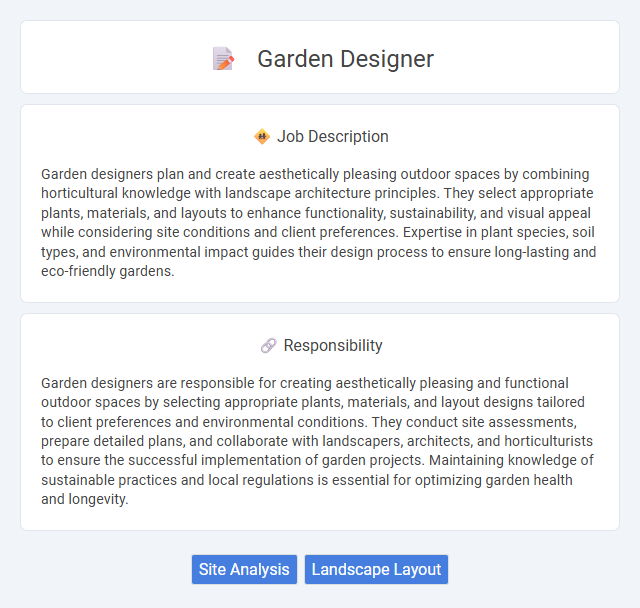
Garden designers plan and create aesthetically pleasing outdoor spaces by combining horticultural knowledge with landscape architecture principles. They select appropriate plants, materials, and layouts to enhance functionality, sustainability, and visual appeal while considering site conditions and client preferences. Expertise in plant species, soil types, and environmental impact guides their design process to ensure long-lasting and eco-friendly gardens.
Individuals with a strong passion for nature, creativity, and attention to detail are likely to thrive as garden designers. Those who enjoy hands-on work, problem-solving, and collaborating with clients may find this career highly satisfying. However, people who prefer routine office tasks or dislike outdoor environments might not be well-suited for this profession.
Qualification
A garden designer typically requires a degree or diploma in horticulture, landscape architecture, or a related field to develop expertise in plant selection, soil management, and garden aesthetics. Proficiency in design software such as AutoCAD or SketchUp enhances the ability to create detailed, accurate garden plans. Strong knowledge of local climate conditions and sustainable gardening practices is essential for crafting functional, environmentally friendly outdoor spaces.
Responsibility
Garden designers are responsible for creating aesthetically pleasing and functional outdoor spaces by selecting appropriate plants, materials, and layout designs tailored to client preferences and environmental conditions. They conduct site assessments, prepare detailed plans, and collaborate with landscapers, architects, and horticulturists to ensure the successful implementation of garden projects. Maintaining knowledge of sustainable practices and local regulations is essential for optimizing garden health and longevity.
Benefit
Garden designer jobs likely offer benefits such as creative freedom to develop unique and personalized outdoor spaces. There is probable job satisfaction stemming from transforming natural environments and enhancing aesthetic appeal. Opportunities for flexible work schedules and collaboration with clients may also be common advantages in this profession.
Challenge
A garden designer's job likely involves overcoming challenges related to balancing aesthetic appeal with environmental sustainability and client preferences. They probably need to address unpredictable factors such as climate conditions and soil quality, which can affect plant selection and garden layout. Problem-solving skills and creativity are expected to be crucial in adapting designs to these evolving constraints.
Career Advancement
Garden designers can elevate their careers by specializing in sustainable landscaping or urban green spaces, attracting high-profile clients and projects that enhance their portfolios. Gaining certifications such as Certified Professional Landscape Designer (CPLD) or LEED accreditation increases credibility and opens doors to senior roles or consultancy positions. Networking within horticultural and architectural circles fosters collaboration opportunities, leading to leadership roles in design firms or launching independent garden design businesses.
Key Terms
Site Analysis
Site analysis is a critical phase in garden design, involving the assessment of soil quality, sunlight exposure, drainage patterns, and existing vegetation to inform sustainable landscaping decisions. Garden designers use detailed site evaluations to optimize plant selection, layout, and hardscape features, ensuring harmony between natural elements and client preferences. Advanced tools like GIS mapping and soil testing enhance accuracy, promoting efficient resource use and long-term garden health.
Landscape Layout
Garden designers specialize in creating functional and aesthetically pleasing landscape layouts that enhance outdoor spaces. They analyze site conditions, soil quality, and climate to select appropriate plants and materials, ensuring sustainable and harmonious designs. Expertise in spatial organization and environmental principles allows garden designers to transform properties into visually appealing and environmentally friendly landscapes.
 kuljobs.com
kuljobs.com